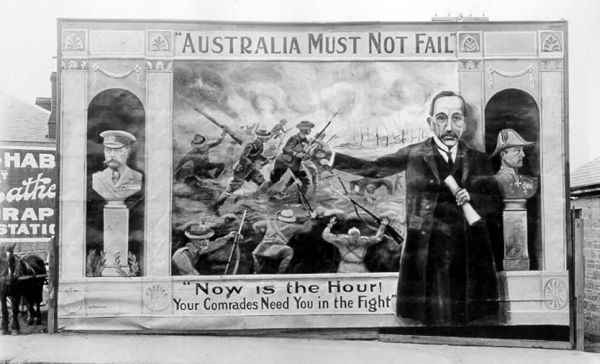 |
 |
|
Conscription
Conscription was necessary, Prime Minister Hughes believed, to counteract reduced Australian enlistments in the defence of Empire during the First World War. Despite massive trade union and Labor Party opposition, he announced a 1916 referendum on conscription. The Tasmanian community was polarised: conscriptionists were dismissed by their opponents as jingoists or murderers, and opponents branded as pro-German traitors. Anti-conscriptionists in Tasmania faced massive opposition, including the conversion of John Earle, the leader of the Tasmanian Labor Party. The only daily newspaper in Australia to back the 'no' cause was the Daily Post, which saw itself as the labour mouthpiece. The Quakers were isolated from other churches in their stand for peace. Unlike Victoria, Tasmania had no Irish Catholic leaders passionately opposed to conscription. Returned soldiers played a prominent role: speaking on platforms, interrupting meetings, writing letters to the press and demanding speaking rights at opposition meetings. A bomb explosion at a Beaconsfield conscription meeting further damaged the opposition cause. Although Hughes' proposal was defeated overall, Tasmanians voted by a large majority – 48,493 votes to 37,833 – for conscription, with the largest 'yes' vote from the west coast stronghold of Labor and unionism. Franklin, a largely rural electorate fearful that labour shortages would worsen, came closest to voting 'no'. Labor forces were in disarray after this result, with the formal split of the Labor Party, Earle's resignation from the Tasmanian branch, and a general strike which saw trade and shipping disrupted. In 1917, with voluntary recruiting insufficient to replace the 38,000 Ypres casualties, Hughes announced another referendum. This campaign was marked by sectarian animosity, largely from the conscriptionist press. The Mercury exacerbated mutual antagonism between Protestants and Catholics through reports of Irish rebellions, aided by German gold and led by Catholic priests. Returned soldiers were again prominent, but increasingly spoke against conscription. This campaign saw less personal bitterness and hostility, although language was still extreme and meetings were rowdy and disorderly – particularly those addressed by visiting anti-conscription speakers Vida Goldstein and Frank Anstey. Conscription was rejected a second time. In the most significant swing away from conscription in Australia, the previous Tasmanian majority of over 10,000 for the proposal dwindled to a mere 379. Hughes had seemingly alienated many by his bad faith and dictatorial leanings, while the Daily Post had been crucial in securing the increased 'no' vote. The rural community again voted 'no' and there was a marked swing back on the west coast. Curtin's Labor government avoided divisiveness during the Second World War as forces serving in the South West Pacific War Zones were closely associated with the defence of Australia. Troops serving in Korea, Malaya and Borneo were all volunteers. The conscription issue was reignited during the Vietnam War. In 1964 the Liberal Menzies government introduced a National Service scheme based on a 'birthday ballot' of 20-year-old men to supplement the Regular Army. There were 2264 Tasmanian conscripts called up under this scheme, which was suspended by the newly elected Whitlam Labor government in 1972. Further reading: M Lake, A divided society, Melbourne, 1975. Wendy Rimon
|
Copyright 2006, Centre for Tasmanian Historical Studies |
